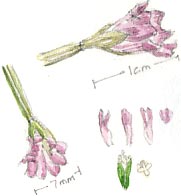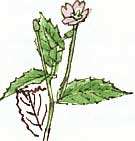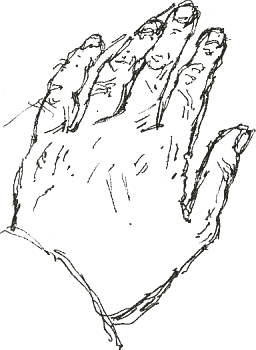 Broad-leaved Willowherb
Broad-leaved Willowherb Broad-leaved Willowherb
Broad-leaved WillowherbWild West Yorkshire, Saturday 23 October 2010
previous | this month | next
 THIS SMALL broad-leaved willowherb Epilobium montanum, was growing within arm's reach of our front door, in the bed by the hostas. I don't normally pick wild flowers but this is a widespread weed and, because it can spread by underground stems, it can become troublesome. It gives me a chance to take a closer look to examine the parts of the flower.
THIS SMALL broad-leaved willowherb Epilobium montanum, was growing within arm's reach of our front door, in the bed by the hostas. I don't normally pick wild flowers but this is a widespread weed and, because it can spread by underground stems, it can become troublesome. It gives me a chance to take a closer look to examine the parts of the flower.
 There are four notched petals but the four green sepals that protected them when the flower was in bud are fused together into a calyx. The most conspicuous part when you look inside the flower is the cross-shaped stigma, the female part which receives the pollen. In some similar-looking species of willowherb the stigma is club-shaped. It pays to look closely if you're trying to identify a flower, although I'm struggling with a smaller detail: grouped around the stigma I can just see, with the aid a of magnifying glass, four inconspicuous male stamens. The book tells me that I should be able to see eight.
There are four notched petals but the four green sepals that protected them when the flower was in bud are fused together into a calyx. The most conspicuous part when you look inside the flower is the cross-shaped stigma, the female part which receives the pollen. In some similar-looking species of willowherb the stigma is club-shaped. It pays to look closely if you're trying to identify a flower, although I'm struggling with a smaller detail: grouped around the stigma I can just see, with the aid a of magnifying glass, four inconspicuous male stamens. The book tells me that I should be able to see eight.
What appears to be the rather thick, grooved, green stem of the flower will become the seed-pod, which will split to release its fluffy seeds.
The genus name Epilobium refers to the flower being at the top of the seed-pod; epi means above and lobium, or lobos, is a pod.
 In her book Hancox, A House and a Family, Charlotte Moore describes how her great-great uncle Norman Moore (1847-1922), started as a boarder at a school in Lancaster which, although enlightened and humane compared with many schools of the period, proved rather dreary to a bright, ever curious boy as the teacher insisted on going over each lesson again and again and again until it had been 'mastered in and out'.
In her book Hancox, A House and a Family, Charlotte Moore describes how her great-great uncle Norman Moore (1847-1922), started as a boarder at a school in Lancaster which, although enlightened and humane compared with many schools of the period, proved rather dreary to a bright, ever curious boy as the teacher insisted on going over each lesson again and again and again until it had been 'mastered in and out'.
This isn't the ideal environment for learning; as Norman Moore put it:
“We acquire experience in life in fragments and imperfect as they are they help us on to something more and open our eyes to things of interest. Thus we learn from both men and books: an absolute thoroughness in learning retards progress and destroys interest.”
'You have much to learn, grasshopper', was the catch-phrase of the wise old priest Kung Fu, the 1970s western series, but I'm with Moore; I think the way to learn is to hop around a bit and not get too bogged down.
Richard Bell, illustrator
previous | this month | Wild West Yorkshire home page | next